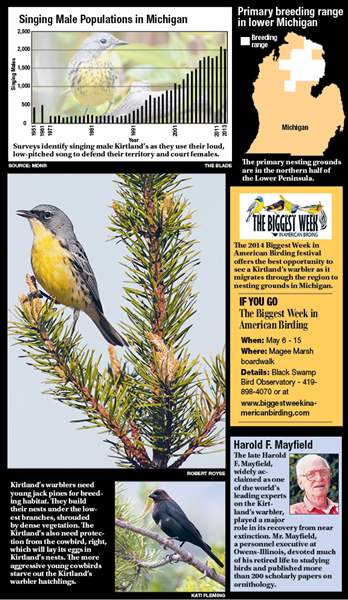
TOLEDO MAGAZINE
Kirtland’s warbler makes a comeback
Still rare, it’s the star of the spring migration
4/27/2014

The Kirtland’s warbler is quite persnickety about its surroundings, especially when love is in the air. Its needs almost led to its extinction.
“This species is a specialist, and specialists are the ones that get into trouble,” said Mark Shieldcastle, an avian biologist who banded his first Kirtland’s warbler in 1980.
Kirtland’s warblers nest on the ground under the lowest branches of young jack pines, and they prefer trees just five to eight years old. Once the tree grows tall enough that the bottom branches die, the jack pine no longer provides suitable nesting for the Kirtland’s.
“There’s a very small window, since it has to be a certain tree of a certain age,” Mr. Shieldcastle said. “Since that type of habitat was disappearing, these birds were pushed very close to the brink. ”
The Kirtland’s warbler was further threatened by the brown-headed cowbird, a parasitic species that lays its eggs in the nests of the warblers. The Kirtland’s raise the young cowbirds, which would out-compete the young warblers.
■ In 1851 a migrating male is discovered on the Clevelandarea farm of Dr. Jared P. Kirtland, a physician and naturalist whose name is attached to the species.
■ In 1879 a specimen is collected on Andros Island in the Bahamas, revealing the fall and winter range of the Kirtland’s warbler.
■ In 1903 Norman A. Wood discovers a Kirtland’s nest in Oscoda County in the northern part of Michigan’s Lower Peninsula.
■ This songbird measures about 5.75 inches long and weighs about one-half ounce
■ The average life expectancy of a Kirtland’s warbler is two years.
■ The Kirtland’s diet includes a variety of insects and ripe blueberries.
■ Kirtland’s migrate at night, increasing the risk of contact with towers or wind turbines.
“They essentially got hit with a double-whammy,” said Mr. Shieldcastle, who works as the research director for the Black Swamp Bird Observatory after a distinguished career as an avian biologist with the ODNR. “We had much fewer nesting pairs due to the habitat situation, and those that did nest had less success, due to the cowbirds.”
A cowbird-trapping program was started, and during the breeding season thousands of these birds were removed from the Kirtland’s extremely limited habitat. Then a tragic accident took place that ultimately provided the key to the Kirtland’s warbler surviving.
During a prescribed burn intended to clear small areas, the flames got out of control. Thousands of acres in Michigan’s Mack Lake area burned in the 1980 fire, and a young firefighter was killed.
“When that huge area recovered and those jack pines grew to the right age, we had much greater habitat ,” Mr. Shieldcastle said. “From that tragedy, and those inadvertent circumstances, there was a benefit. That fire was an eye-opener.”
With an active program controlling the cowbird problem, and its range of suitable nesting habitat dramatically increased, the Kirtland’s warbler started to recover. It went from an estimated population of just 200 in 1971, teetered on the brink of extinction for nearly two decades, and then started a strong recovery arc about 1990. There should be several thousand Kirtland’s using the primary nesting region this spring, while additional smaller breeding sites have been identified in Wisconsin, Ontario, and in the Upper Peninsula.
“The Kirtland’s warbler gives us a good example of a big picture recovery and the importance of taking into account the value of habitat,” Mr. Shieldcastle said. “Habitat is the answer, and that massive block of habitat created by the burn allowed this bird to come back. It is still endangered, but as a result of that change in the amount of habitat, we have a stable population, and multiple population sites.”
Kirtland’s warblers winter in scrub thickets in the Bahamas, but the route they take to get there, and their return path to the breeding grounds, is a mystery.
“Presumably, it migrates more or less straight back and forth between those end points, but we don’t really know that,” said avian author and naturalist Kenn Kaufman. “Records of birds seen on migration are extremely few, scattered, and unpredictable.”
The best opportunity to see a Kirtland’s warbler outside of its breeding or wintering grounds comes in early May along Lake Erie. Like many other warblers, the Kirtland’s use the woody marshes near the lake to rest and refuel before flying across that wide stretch of open water. Thousands of birders converge on the region for the Biggest Week in American Birding festival, and the opportunity to view these neo-tropical migratory birds.
“There’s a good chance that most of the world’s population of Kirtland’s warblers goes right through here,” Mr. Shieldcastle said. “It is still rare, but there’s a chance you will see one.”